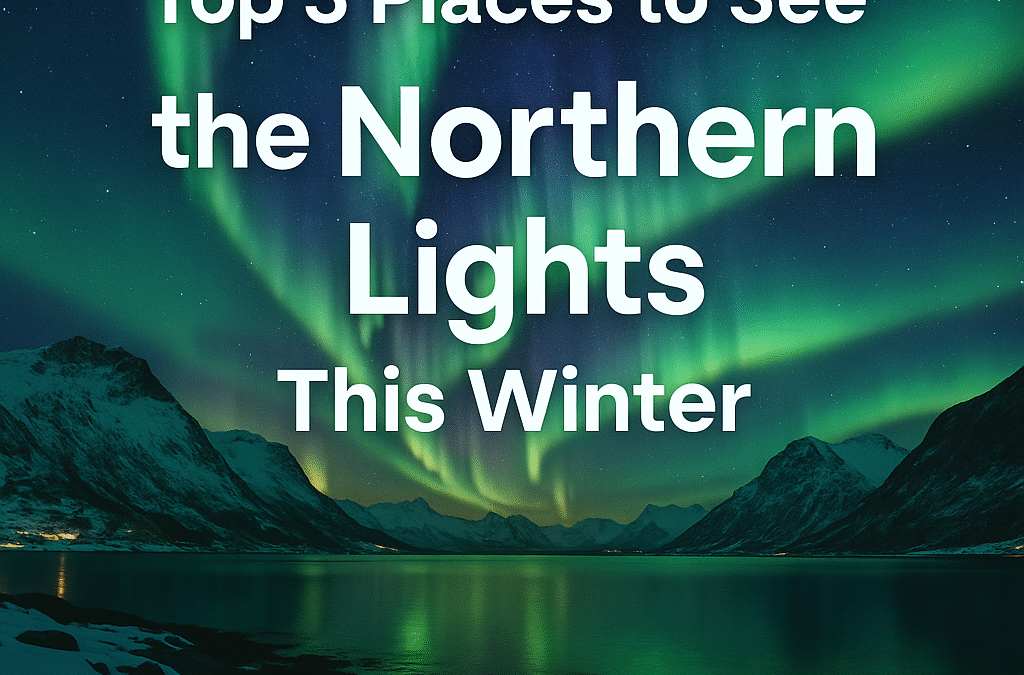The Northern Lights (or Aurora Borealis) are one of the most breathtaking natural phenomena on Earth — and if you’re an Aussie dreaming of snowy skies lit up with waves of green and pink light, this winter is the perfect time to go.
🌌 What Are the Northern Lights?
The Northern Lights are caused by charged particles from the sun colliding with gases in the Earth’s atmosphere near the magnetic poles. The result? Stunning curtains of light that dance across the night sky — glowing green, purple, and even red on rare occasions.
📆 When’s the Best Time to See Them?
The Northern Lights are best seen between late September and mid-April, when the skies are darkest. Peak viewing is typically December to March — which also happens to align with the Australian summer holidays, making it ideal for Aussie travellers.
Here are the top 3 destinations to catch this amazing light show this upcoming winter — complete with travel tips, must-see sights, and typical hotel costs.
1. Tromsø, Norway
Tromsø is known as the “Gateway to the Arctic”, and is arguably one of the best places in the world to see the Northern Lights. It’s located right in the middle of the auroral oval — the zone with the highest aurora activity.
🔍 What to do:
- Take a Northern Lights chase tour in a heated minibus or snowmobile
- Visit the Arctic Cathedral and Fjellheisen Cable Car for panoramic views
- Try local Arctic cuisine and visit a Sámi reindeer camp
💰 Hotel Cost:
Expect to pay around AUD $250–$350 per night for a 3–4 star hotel in winter.
📍 Learn more:
2. Abisko, Sweden
Abisko is a small village in Swedish Lapland that offers some of the clearest and most consistent Northern Lights sightings in the world, thanks to its “blue hole” microclimate which often keeps the skies clear even when it’s cloudy elsewhere.
🔍 What to do:
- Visit the Aurora Sky Station — a mountaintop observatory with one of the best views in Europe
- Go dog sledding or cross-country skiing
- Stay in an eco-lodge or mountain cabin for a truly remote experience
💰 Hotel Cost:
Expect to pay around AUD $180–$280 per night for a 3–4 star stay.
Accommodations here can be limited, so book well in advance.
📍 Learn more:
https://www.swedishlapland.com/places/abisko
3. Reykjavik, Iceland
While Reykjavik itself has light pollution, you can see the Northern Lights just outside the city with ease — and it’s a fantastic base for exploring both auroras and Iceland’s otherworldly landscapes.
🔍 What to do:
- Take a guided aurora tour from Reykjavik into the countryside
- Visit the Blue Lagoon or try snowmobiling on a glacier
- Explore the Golden Circle: waterfalls, geysers, and Þingvellir National Park
💰 Hotel Cost:
Expect to pay around AUD $300–$400 per night for a 3–4 star hotel in central Reykjavik.
📍 Learn more:
✈️ Bonus Travel Tips for Aussies
- Book early: Winter aurora season is popular, and hotels/tours can sell out fast.
- Pack warm: Daytime temps can range from –5°C to –20°C. Bring thermals, insulated boots, and a proper down jacket.
- Travel insurance is essential, especially for snow-based activities or flight disruptions due to weather.
- Consider getting a Europe prepaid SIM for easy data access and maps while you’re on the move.
🗺️ Final Thoughts
Seeing the Northern Lights is a once-in-a-lifetime experience — and this northern winter is shaping up to be a great one for aurora activity. Whether you choose the Arctic charm of Tromsø, the quiet skies of Abisko, or the volcanic beauty of Iceland, you’ll be in for something unforgettable.
So start planning now — and don’t forget your camera (and a tripod)!

